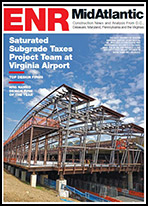DESIGN-BUILD NEW
New Meadowlands Stadium, East Rutherford, N.J.
Skanska
Architect: EwingCole
Engineer: Thornton Tomasetti
Home of the New York Jets and New York Giants, this stadium hosts soccer matches, concerts and other sporting events in addition to NFL games. The 2.1-million-sq-ft facility has seating for 82,500, including 217 suites, upscale clubs and upgraded pedestrian circulation to reduce bottlenecks and improve traffic flow. The New Meadowlands Stadium was completed on budget and five months ahead of schedule. Enhanced site safety, cutting-edge technologies and strong communication contributed to the project’s overall success.
DESIGN-BUILD RENOVATION
The University of Texas MD Anderson Cancer Center Albert B. and Margaret M. Alkek Hospital Expansion, Houston, Texas
McCarthy Building Cos. Inc.
Architect: HKS Architects
Engineer: Walter P. Moore
The 12-story vertical expansion and structural steel horizontal expansion of the University of Texas MD Anderson Alkek forced the McCarthy Building Cos. team to overcome numerous obstacles, including tight space and noise and infection control, to more than double the height of the hospital and add 503,000 sq ft of space. The limited space allowed for only one tower crane, with which the team delivered an innovative solution: build the 12-story expansion around a single tower crane erected in an existing elevator shaft, and then lift sections through the shaft piece by piece. After 31 months of being on call 24/7, McCarthy completed the project on time and on budget.
ENVIRONMENTAL NEW
Round Butte Dam Selective Water Withdrawal Project, Madras, Ore.
Barnard Construction Co. Inc.
Engineer: CH2M Hill
This one-of-a-kind, highly technical project is the result of more than 5 million lb of steel, fabricated into thousands of pieces, delivered in 204 truckloads and constructed in 270 ft of water. The Selective Water Withdrawal Structure in central Oregon’s Lake Billy Chinook was created to subtly change currents in the reservoir and the water temperature downstream of the dam while allowing for fish collection and transfer. The team performed underwater excavation, drilling and grouting using remotely operated vehicles to avoid making risky and time-consuming dives.
ENVIRONMENTAL RENOVATION
Savage Rapids Dam Renovation, Grants Pass, Ore.
Slayden Construction Group Inc.
Engineer: U.S. Bureau of Reclamation
The Savage Rapids Dam was constructed in 1921 to divert water from the Rogue River and supply irrigation water to local farmers. Situated 107 miles from the Pacific, it impacted 500 miles of upstream spawning habitat of salmon and steelhead, blocking fish migration and degrading water quality and habitat. Slayden constructed pumping and conveyance pipeline facilities to replace the dam’s diversion function and removed the Savage Rapids Dam. The project was completed on time and on budget with no lost-time incidents.
FEDERAL & HEAVY NEW
NASA Mobile Launcher, Kennedy Space Center, Fla.
Hensel Phelps Construction Co.
Architect: RS & H
Engineer: RS & H
The NASA Mobile Launcher will be used in the assembly, testing and servicing areas at existing Kennedy Space Center facilities; to transport the space vehicle to the launch pad; and provide ground support for launches. The Mobile Launcher contains two main components: the Mobile Launcher Base, a 25-ft steel section on girder and pipe trusses that contains the facility ground systems, and the Mobile Launch Tower, a 359-ft pipe steel tower that consists of multiple platforms for personnel access and utilities for future rocket use. While two major redesigns, including an almost complete redesign of the electrical system, could have set the project back months, the team absorbed the schedule impact by working 24 hours a day, seven days a week to complete the project on time.
FEDERAL & HEAVY RENOVATION
Seal Observation Facilities Construction Project, St. Paul Island, Alaska
WPC
Architect: Livingston Slone Inc.
Engineer: PND Engineers Inc.
The series of towers and walkways the National Oceanic and Atmospheric Administration used to observe and count the seal population on St. Paul Island, Alaska, were in poor condition and no longer safe for use. The project required replacing seven towers and 1,000 ft of walkways in the small window of time the seals migrate from the island. Custom materials, including fiberglass-reinforced polymers and natural Alaskan cedar, were used as a test for replacing all structures on the island, but delivery was unpredictable and slow. Despite average daily temperatures below zero, strong winds and frequent whiteout conditions, the Wade Perrow team completed the project with zero accidents and no lost-time injuries.
Article toolbar
